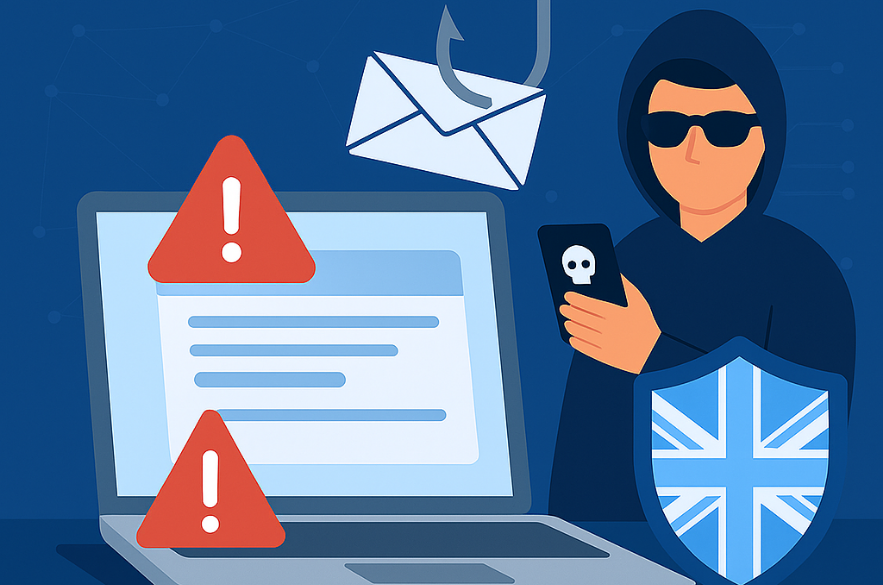SMBs in the UK are under siege. The phishing attacks of old; misspelled domain names and obvious spam are evolving. Phishing 3.0 combines AI, voice deepfakes, SMS deception (smishing), and social engineering to penetrate employee trust and bypass conventional defences. This new wave of attacks doesn’t just steal passwords, it hijacks identities, finances, and reputations.
In fact, a 2024 UK cyber breach survey reported that 84% of organisations claimed to have experienced phishing attacks in the prior year. (See UK Cyber Security Breaches Survey 2024)
Furthermore, 35% of UK SMEs now cite AI-based cyber threats, including advanced phishing, as one of their top concerns.
With regulations like NIS2 and forthcoming UK legislation pushing compliance burdens even on smaller firms, there is no room to ignore phishing threats.
In this guide, you’ll learn how phishing is evolving, how voice, SMS, and social engineering are being weaponised, and what real steps UK SMBs can take to detect and defend, using anti-phishing solutions, training, simulated attacks, and strategic tools.
The New Frontiers of Phishing: Beyond Email
Email Phishing Enhanced by AI
Traditional email phishing remains common, but attackers now use AI to write plausible messages (e.g. mimicking writing style, using context from social media) to fool filters and human readers alike. These messages may combine urgency, personalization, and social proof to push victims into clicking malicious links.
Vishing: Voice Phishing with Deepfakes
Voice-based phishing or vishing is rising. Attackers use deepfake technology to mimic executives’ voices or trusted partners, then instruct employees to make payments or share credentials. In the UK, the regulator Action Fraud notes numerous vishing scams targeting SMEs, especially via impersonation calls.
Smishing (SMS Phishing)
Smartphone penetration means SMS is another attack vector. Smishing sends fraudulent texts that appear to come from banks or suppliers requesting “urgent” login verification or payment. Because mobile interfaces are small and users often act quickly, smishing can be highly effective.
Social Engineering Beyond Phishing
Phishing 3.0 also includes business email compromise (BEC), invoice fraud, and fake invoice/email scams. These rely on social engineering, not technical exploits; using trust, human error, and supply chain relationships to trick staff into paying bogus invoices or revealing credentials.
Why SMBs Are Especially Vulnerable
- Under-resourced security teams: Many SMBs lack dedicated cybersecurity staff to spot AI-enhanced phishing.
- Less awareness/training: Employees may not recognise advanced deception tactics.
- Reliance on digital transactions: Payment workflows, supplier portals, and remote work increase exposure.
- Regulatory pressure: Even smaller firms may face requirements under NIS2, or be suppliers to larger companies that are regulated.
Five-Step Defense Strategy for Phishing 3.0
| Step | Action | Key Focus |
| 1) Assess current threat vectors | Audit where your business is exposed: email, phone, SMS, vendor supply chain. | Identify your most vulnerable domain (e.g. payments, supplier invoices). |
| 2) Deploy anti-phishing solutions | Use secure email gateways, AI-based email filters, phone verification systems. | Tools need to detect AI-crafted phishing, deepfake content, link rewriting. |
| 3) Simulated phishing & training | Launch controlled phishing / smishing / vishing simulations for staff. | Use feedback loops to double down on weak spots. |
| 4) Incident response planning | Prepare protocols: block domains, notify staff, reverse payments when possible. | Ensure quick escalation when simulation or real attempt is caught. |
| 5) Monitor, review, iterate | Watch trends, false positives, messages bypassing filters, staff behavior. | Continuously update filters, training and controls. |
Tools & Solutions for SMBs in the UK
- Secure Email Gateways (SEG) with AI: Gateways that scan messages for anomalies, rewritten links, suspicious attachments.
- Anti-Phishing Services & Platforms: Vendors offering phishing detection, threat intelligence, and staff simulation.
- Voice Authentication / Voice AI Detection: Tools that analyse caller identity, voice anomalies, or require secondary verification.
- SMS / Mobile Filtering Tools: Mobile threat detection tools that flag suspicious SMS links.
- Security Awareness Platforms: Platforms to deliver phishing, vishing, smishing simulations and education for staff.
- SIEM / XDR Integration: Logging and alerting when suspicious email or call events occur, combined with network telemetry to catch anomalous behavior.
Metrics & Indicators of Success
To validate your anti-phishing investment:
- Click-through rates on simulated phishing emails
- Number of reported suspicious emails / calls by staff
- Number of prevented phishing incidents
- Time to detection / response
- False positive rate (legitimate messages blocked)
- User feedback and confidence levels
Final Thoughts
Phishing 3.0 is not just an email problem, it’s a cross-channel, socially engineered, AI-enhanced threat. For UK SMBs, staying ahead means combining prevention tools, staff training, simulations, and a response plan.
At I-NET Software Solutions, we help SMBs deploy comprehensive anti-phishing strategies, including simulated attacks, filtering tools, and staff training tailored to your business size and budget.
Book a security assessment to test your exposure and begin your journey to resilience.
For context on how phishing fits into compliance and broader security obligations, check out our blog
Zero Trust for Small Businesses: Why It’s No Longer Optional.
